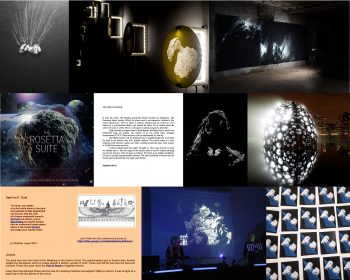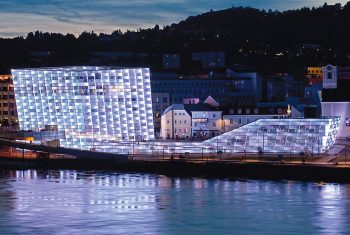Over the past two years, Rosetta has approached, reached and followed Comet 67P/Churyumov-Gerasimenko, collecting unprecedented images and other scientific data and dropping the Philae lander on to its surface to perform in-situ measurements.
While communicating the mission’s milestones, operational activities and scientific results via this blog and other social media channels, we have been pleased with the enormous impact that the mission had – and still has – on the public.

A selection of artworks inspired by the Rosetta mission. Top row: Christine Rueter; Solimán López; Ekaterina Smirnova. Middle row: Edward Blakeley; Stephen Oliver; John Elcock; David Delgado, Dan Goods & Studio KCA. Bottom row: Siobhan Logan; Angelina Yershova & Stefano Giovanardi; Guilherme Pontes. For more details about these and other artworks, visit: https://rosetta-art-tribute.tumblr.com
Among the many comments, questions and feedback we have received over the months, there were also some special messages: they came from artists across the world, who had been especially impressed and inspired by the incredible adventure of Rosetta and Philae.
They had spontaneously dedicated paintings, poems, songs, symphonies and a variety of other artworks to this unique mission, and wanted to share them with us.
Then we started searching the web, and were astonished to find even more artistic tributes to the mission.
Today, we are sharing this collection online by launching a new web-based platform: the “Rosetta Art Tribute” tumblr, to collect artworks based on different media that have been inspired by ESA’s comet-chasing mission.
This repository of artistic tributes expands on a post, “Music of the irregular spheres”, that was published on this blog in late 2014 to celebrate the many musical tributes that had been dedicated to Rosetta, Philae and Comet 67P/C-G around the time of comet landing.
So far, the Rosetta Art Tribute collection includes paintings, silk-prints, sculptures, etchings, drawings, photographs, poems, musical suites, symphonies, songs, live-concerts, performances, installations, a sci-fi film (co-produced by ESA), comics, cartoons, and more.
We are delighted to see that the Rosetta mission has such a strong and long-lasting impact on the imagination and work of many artists. This is a testament to the mutual spirit of quest, research and exploration that is pursued, albeit with different tools, by scientists and artists alike.
We wish to send our warmest thanks to all the artists who chose to dedicate their pieces to Rosetta for their enthusiasm and for having let the mission become part of their artistic process.
This collection is by no means complete, and is maintained on a best-effort basis. We hope that it will grow with time, and if you are an artist (or know one) who has been inspired by the Rosetta mission and would like your work to be featured, please contact us via the tumblr or via this blog.

The Ars Electronica Center in Linz, Austria. Credit: N. Ferrando & L. Lammerhuber
As a final note, we would like to advertise an artistic residency that ESA has recently launched in partnership with the Austrian institution Ars Electronica to research an interdisciplinary project bridging the domains of art and space science.
The residency project can be based on any subject from ESA’s space science programme (including, of course, the Rosetta mission!) and will take place in the second half of 2016. The deadline to apply is 6 June has been updated to 20 June.









Discussion: 5 comments
Hi Claudia,
Though no artist by any means, the astounding images from the Rosetta mission have inspired me. I have already cobbled together one video and I am currently working my way through the mountain of NAVCAM and OSIRIS images recently released to find some more images to make another one. My problem is that I need to crop the images to a 16:9 aspect ratio to look good on screen. With this amount of images that becomes a major task. It does however mean I often end up rotating images or cropping them to focus on smaller scale landscape features which often gives a totally different perspective to the images. Are future ESA missions going to be using cameras that take 16:9 aspect ratio images?
You are welcome to add my humble video to your collection.
https://www.youtube.com/watch?v=PjivRS_Gvzg
Many, many thanks to all the imaging teams and especially to those who have worked so hard to make them so accessible to the public.
A interesting piece which is encouraging
For some unknown reason unable to access when first published.
Now able from this austere platform. Wow!
This is the first repository I meet about anything Science related. How could science be inherited without Art?
Feeling like a kid 😀
There are Hearts at Coraline…
“To fully appreciate the complexities of nature and reach more people in explaining them, academics and scientists must approach… with… a recognition of the emotional, cultural, ethical and spiritual perspectives on the world…”
ASU Michael Crow.
Resource at:
https://quod.lib.umich.edu/cgi/p/pod/dod-idx/academic-engagement-in-public-and-political-discourse.pdf?c=mm;idno=13950883.0001.001
Via:
https://theconversation.com/the-limits-of-intellectual-reason-in-our-understanding-of-the-natural-world-60080